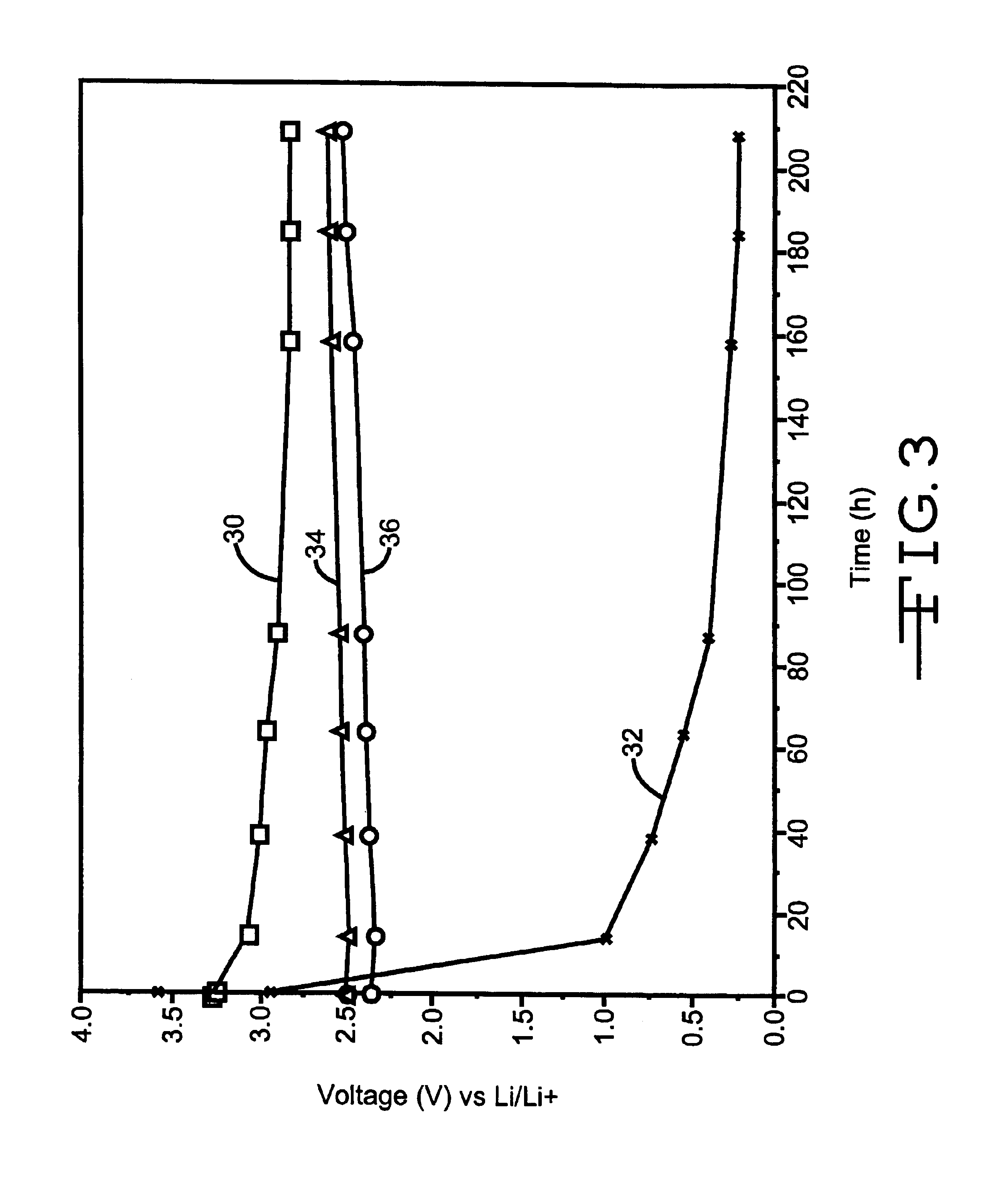Anode for nonaqueous secondary electrochemical cells
a secondary electrochemical and anode technology, applied in the direction of non-aqueous electrolyte cells, cell components, electrochemical generators, etc., can solve the problems of poor capacity retention upon cycling and low capacity of copper oxide, so as to improve the performance of lithium ion secondary cells, improve cell end of service indication, and prevent corrosion
- Summary
- Abstract
- Description
- Claims
- Application Information
AI Technical Summary
Benefits of technology
Problems solved by technology
Method used
Image
Examples
example ii
Electrochemical Test of Anode Mixtures
The performance of the various mixtures of graphite and lithiated metal vanadium oxides described in Example I as mixed material electrodes for secondary nonaqueous electrochemical cells was tested versus a lithium metal counter electrode in nonaqueous electrolyte. To assemble a test cell, the various mixed material electrodes were placed between two layers of polyethylene separator. In each cell, a counter electrode of excess lithium metal pressed to a nickel current collector was placed against the top piece of separator facing the mixed material electrode. The electrodes were wound together in a "jelly-roll" configuration to form a spirally wound electrode assembly. The cells were then activated with 1M LiPF.sub.6 or 1M LiAsF.sub.6 , in EC / DMC (3:7) electrolyte under vacuum.
The rechargeable test cells were first discharged at a constant current (0.5 mA / cm.sup.2) to +0.02 V vs. Li / Li.sup.+, and then charged at a constant current (0.5 mA / cm.sup...
example iii
Open Circuit Storage of Electrochemical Cells
Lithium ion electrochemical cells were assembled as described above, activated with 1M LiAsF.sub.6 EC / DMC (3:7) electrolyte, and allowed to stand under open circuit condition at room temperature for several days. The plot of open circuit voltage (OCV) as a function of stand time is shown in FIG. 3, wherein curve 30 is of the test cell having graphite only in the electrode opposite the excess lithium, curve 32 is of the test cell having graphite / Cu.sub.0.5 Ag.sub.0.5 V.sub.2 O.sub.y, curve 34 is of the test cell having graphite / Li.sub.x AgV.sub.2 O.sub.y, and curve 36 is of the test cell having graphite / Li.sub.x Cu.sub.0.5 Ag.sub.0.5 V.sub.2 O.sub.y. Electrochemical cells containing no additive (curve 30) and Cu.sub.0.5 Ag.sub.0.5 V.sub.2 O.sub.5.75 additive (curve 32) displayed a significant decrease in OCV over time, while cells with Li.sub.x AgV.sub.2 O.sub.5.5 (curve 34) or Li.sub.x Cu.sub.0.5 Ag.sub.0.5 V.sub.2 O5.75 (curve 36) displa...
example iv
End of Service Indication in Lithium Ion Cells
It is known that lithium ion cells utilizing graphite negative electrodes provide little end of service (EOS) indication on the discharge step due to the relatively flat charge / discharge curve for graphite. An illustration of this point is given in FIG. 4, which displays the voltage vs. time curve 40 for a graphite electrode with no additive cycled versus a lithium metal counter electrode. At the end of the delithiation of the graphite electrode (corresponding to the discharge of a lithium ion cell), a sharp rise in voltage is observed (at about 15 to 16 hours).
In comparison, the delithiation of graphite electrodes containing 25% Cu.sub.0.5 Ag.sub.0.5 V.sub.2 O.sub.5.75 or 25% Li.sub.x Cu.sub.0.5 Ag.sub.0.5 V.sub.2 O.sub.5.75 display a slower ramp to end of service (see FIG. 1 at about 18 hours for the former material). The practical application of this is that lithium ion cells containing graphite / additive mixed material negative electr...
PUM
| Property | Measurement | Unit |
|---|---|---|
| weight percent | aaaaa | aaaaa |
| temperature | aaaaa | aaaaa |
| temperatures | aaaaa | aaaaa |
Abstract
Description
Claims
Application Information
 Login to View More
Login to View More - R&D
- Intellectual Property
- Life Sciences
- Materials
- Tech Scout
- Unparalleled Data Quality
- Higher Quality Content
- 60% Fewer Hallucinations
Browse by: Latest US Patents, China's latest patents, Technical Efficacy Thesaurus, Application Domain, Technology Topic, Popular Technical Reports.
© 2025 PatSnap. All rights reserved.Legal|Privacy policy|Modern Slavery Act Transparency Statement|Sitemap|About US| Contact US: help@patsnap.com



